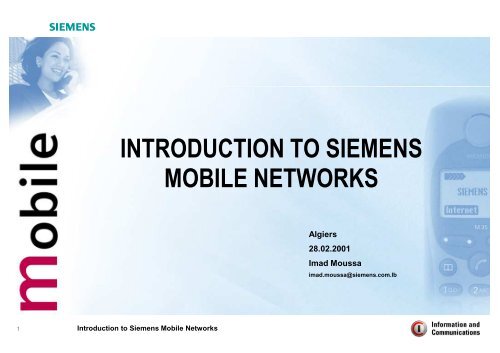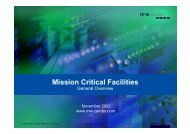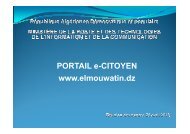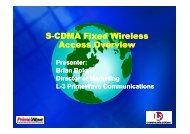introduction to siemens mobile networks
introduction to siemens mobile networks
introduction to siemens mobile networks
Create successful ePaper yourself
Turn your PDF publications into a flip-book with our unique Google optimized e-Paper software.
INTRODUCTION TO SIEMENS<br />
MOBILE NETWORKS<br />
Algiers<br />
28.02.2001<br />
Imad Moussa<br />
imad.moussa@<strong>siemens</strong>.com.lb<br />
1 Introduction <strong>to</strong> Siemens Mobile Networks
Public Land Mobile Network (PLMN)<br />
System Architecture<br />
Mobile Station<br />
Base station<br />
subsystem BBS<br />
BTS<br />
BSC<br />
Switching subsystem SSS IN Other <strong>networks</strong><br />
AC<br />
HLR<br />
Operation + maintenance subsystem<br />
OMS<br />
VLR<br />
EIR<br />
MSC/ SSP<br />
SMP<br />
SCP<br />
PSTN<br />
ISDN<br />
Data<br />
<strong>networks</strong><br />
PLMN<br />
Value added services<br />
CBS<br />
ABC<br />
VMS OAS SMS<br />
ABC<br />
AC<br />
BSC<br />
BTS<br />
CBS<br />
Administration and Billing Center<br />
Authentication Center<br />
Base Station Controller<br />
Base Tranceiver Station<br />
Cell Broadcast Service<br />
EIR<br />
HLR<br />
MSC<br />
OAS<br />
SCP<br />
Equipment Identification Register<br />
Home Location Register<br />
Mobile Services Switching Center<br />
Opera<strong>to</strong>r Assistance Service<br />
Service Control Point<br />
SMP<br />
SMS<br />
SSP<br />
VLR<br />
VMS<br />
Service Management Point<br />
Short Message Service<br />
Service Switching Point<br />
Visi<strong>to</strong>r Location Register<br />
Voice Mail Service<br />
2 Introduction <strong>to</strong> Siemens Mobile Networks
SIEMENS MOBILE NETWORKS<br />
Base Station Subsystem<br />
Switching Subsystem<br />
Telecommunication Management Network<br />
Conclusion<br />
3 Introduction <strong>to</strong> Siemens Mobile Networks
BS-240/241: Features and advantages<br />
Compatibility with SBS<br />
Flexible Multistandard Architecture<br />
Rack extension up <strong>to</strong> 72 TRX/site (3x24)<br />
Redundancy for all core modules<br />
Combining / TMA: all types for up <strong>to</strong> 8 TRX<br />
Integrated Abis cross connect: 8 PCM lines<br />
Smart antennas: Beam switching, beam forming prepared<br />
High site efficiency<br />
(BS240: 54 liters/TRX, i.e. 30 % vol. red.)<br />
Extended temperature up <strong>to</strong> 50ºC / 55ºC<br />
State of the art technology, enviromentfriendly<br />
BS-240<br />
BS-241<br />
4 Introduction <strong>to</strong> Siemens Mobile Networks
BS-40/41<br />
Self-contained Base Station<br />
FP<br />
A<br />
C<br />
O<br />
M<br />
ON<br />
ON<br />
air inlet<br />
CU CU<br />
ON ON ON<br />
ON ON<br />
A<br />
C<br />
O<br />
M<br />
C<br />
O<br />
B<br />
A<br />
C<br />
O<br />
S<br />
A<br />
ON<br />
ON<br />
DIAMCO<br />
C<br />
O<br />
B<br />
A<br />
C<br />
O<br />
S<br />
A<br />
ON<br />
ON<br />
ON<br />
Standard<br />
Battery<br />
Module<br />
air inlet<br />
BS-40<br />
CB<br />
CU CU<br />
4 TRX Single Rack solution<br />
Same modules as used for BS-24x<br />
Service Rack SR-240/241 optionally usable<br />
Battery set for battery back-up<br />
Design for Single Phase AC power supply<br />
19” link equipment<br />
air inlet<br />
air inlet<br />
AC/DC<br />
AC/DC<br />
AC/DC<br />
AC-Panel<br />
µWave (2HU)<br />
air inlet<br />
air inlet<br />
Multiple options for antenna combining using<br />
DUAMCO and FICOM allow for realization of a large<br />
variety of possible cells<br />
5 Introduction <strong>to</strong> Siemens Mobile Networks
New Micro Base Station (eMicro BTS)<br />
The eMicro BTS is a new future-proof evolution<br />
of Siemens BTS.<br />
A new modular highly flexible architecture<br />
enables the new Micro BTS platform <strong>to</strong> support<br />
features which in the past were reserved <strong>to</strong><br />
macro base stations.<br />
Having the same software base it is fully<br />
compatible with Siemens<br />
BS-240/241, BS-20/21/22 and<br />
BS-60/61 products.<br />
6 Introduction <strong>to</strong> Siemens Mobile Networks
Pico BTS Architecture<br />
Agent 1<br />
Pico Server<br />
BSC<br />
A bis 1,5 km<br />
Agent 2<br />
Multidrop <strong>to</strong> other Pico Servers or BTS<br />
Fully integrated in<strong>to</strong> SBS family concept<br />
Same HW Platform as BS240<br />
Agent 24<br />
7 Introduction <strong>to</strong> Siemens Mobile Networks
Siemens BSC<br />
You are looking for:<br />
sleek solutions for modern sophisticated cellular <strong>networks</strong><br />
featuring:<br />
8 Introduction <strong>to</strong> Siemens Mobile Networks
Special Features of Siemens BSC<br />
Optimum use of PCM links<br />
TRAU located at MSC<br />
BSC acts as controller and concentra<strong>to</strong>r<br />
BTSE<br />
BTSE<br />
BSC<br />
TRAU<br />
MSC<br />
BTSE<br />
BTSE<br />
16kbit/s<br />
64kbit/s<br />
BSC remote from TRAU & MSC for a highly cost efficient use of PCM links<br />
9 Introduction <strong>to</strong> Siemens Mobile Networks
Siemens – Smallest BSC<br />
Siemens offers smallest and lightest BSC on the market<br />
no raised floors or air conditioning necessary<br />
Siemens BSC renowned for very low power consumption<br />
harmless <strong>to</strong> the environment<br />
10 Introduction <strong>to</strong> Siemens Mobile Networks
Advantages – Siemens BSC<br />
smallest and lightest BSC in the market<br />
low power consumption<br />
operation in wide temperature range<br />
flexible non-blocking switching network<br />
intelligent network <strong>to</strong>pology<br />
highly efficient use of leased lines<br />
special Abis features<br />
11 Introduction <strong>to</strong> Siemens Mobile Networks
SIEMENS MOBILE NETWORKS<br />
Base Station Subsystem<br />
Switching Subsystem<br />
Telecommunication Management Network<br />
Conclusion<br />
12 Introduction <strong>to</strong> Siemens Mobile Networks
Flexibility of the EWSD Platform<br />
CDMA<br />
PSTN/<br />
ISDN/<br />
SSP<br />
GSM/<br />
SSP<br />
13 Introduction <strong>to</strong> Siemens Mobile Networks
EWSD Supports Interfaces <strong>to</strong> Various Networks<br />
Telephony<br />
ISDN<br />
Global network<br />
Internet<br />
Mobile network<br />
PSTN<br />
Public switched<br />
packet data network<br />
Mobile<br />
ADMOSS<br />
EWSD<br />
Corporate<br />
private network<br />
Intelligent<br />
network<br />
Access<br />
<strong>networks</strong><br />
TMN<br />
ADMOSS<br />
PSTN<br />
Advanced multifunctional<br />
operation service system<br />
Public switched<br />
telephone network<br />
14 Introduction <strong>to</strong> Siemens Mobile Networks
Switching Subsystem Configurations<br />
AC<br />
Integrated MSC/VLR<br />
Integrated HLR/AC<br />
Integrated MSC/VLR-EIR<br />
Integrated MSC/VLR-HLR/AC<br />
Integrated MSC/VLR-HLR/AC-EIR<br />
HLR<br />
VLR<br />
EIR<br />
BTS<br />
BSC<br />
MSC/SSP<br />
ISDN<br />
PSTN<br />
switch<br />
OMS<br />
15 Introduction <strong>to</strong> Siemens Mobile Networks
Switching Subsystem Architecture<br />
Digital trunks with CCS7 <strong>to</strong> BSC<br />
Digital trunks with CSS7 or channel<br />
assoc. signaling <strong>to</strong> other <strong>networks</strong><br />
CCS7 links <strong>to</strong><br />
Interface <strong>to</strong><br />
HLR/ AC<br />
EIR<br />
MSC/ VLR<br />
O&M center<br />
IWF<br />
LTG<br />
LTG<br />
LTG<br />
LTG<br />
CCNC<br />
CP<br />
SN<br />
MSC/VLR<br />
CCS7 links <strong>to</strong><br />
MSC/VLR<br />
HLR/AC<br />
LTG<br />
CCNC<br />
SN<br />
HLR/ AC<br />
Interface <strong>to</strong><br />
O&M center<br />
CP<br />
16 Introduction <strong>to</strong> Siemens Mobile Networks
Example: Large Configuration 260 000 Subscriber<br />
System Data:<br />
Size:<br />
Application:<br />
Benefits:<br />
up <strong>to</strong> 500 LTGs (2000 PCM30)<br />
64 MB in LTG Memory<br />
512 MB in Common Memory<br />
9,1 GB Magnetic Disc Device<br />
Power consumption: approx. 7kW<br />
10 Racks MSC/VLR (25 sqm)<br />
3 Racks HLR/AC (15 sqm)<br />
High subscriber density, City Areas<br />
High Capacity<br />
Lowest space requirements for systems of<br />
this capacity<br />
Up <strong>to</strong> 50% lower power consumption than<br />
comparable systems<br />
17 Introduction <strong>to</strong> Siemens Mobile Networks
Siemens Switching Subsystem Configurations<br />
Benefits:<br />
Compatibility<br />
HLR & MSC constructed according <strong>to</strong><br />
the same design rules<br />
Smooth interworking<br />
Flexibility<br />
Change from integrated <strong>to</strong> stand-alone solutions possible<br />
Safe investment as just software has <strong>to</strong> be modified in case<br />
of change of network entity function<br />
18 Introduction <strong>to</strong> Siemens Mobile Networks
Siemens Switching System<br />
Siemens SSS provides<br />
a flexible SSS platform for network<br />
evolution and the realization of future<br />
network requirements<br />
a fully featured system<br />
(GSM phase 1, 2 and 2+)<br />
outstanding reliability and availability<br />
figures<br />
the highest performance figures<br />
for fast growing <strong>networks</strong><br />
19 Introduction <strong>to</strong> Siemens Mobile Networks
IN – System Architecture<br />
SMP<br />
X.25<br />
SMP<br />
SCP<br />
SSP<br />
Service Management Point<br />
Service Control Point<br />
Service Switching Point<br />
SSP<br />
MSC/VLR<br />
SSP<br />
MSC/VLR<br />
BSS<br />
SCP<br />
INAP<br />
ISUP<br />
MSC/VLR<br />
SSP<br />
MSC/VLR<br />
BSS<br />
INAP<br />
ISUP<br />
MAP<br />
IN Application Part<br />
ISDN User Part<br />
Mobile Application Part<br />
BSS<br />
BSS<br />
BSS<br />
HLR/AC<br />
20 Introduction <strong>to</strong> Siemens Mobile Networks
The Permanent Evolution of MSC<br />
Reduces Life Cycle Cost ...<br />
Floor space<br />
Power consumption<br />
100%<br />
100%<br />
54 %<br />
34 %<br />
Features<br />
1991 1997/98 1991 1998<br />
HW faults<br />
System down<br />
No. of<br />
features<br />
250<br />
HW<br />
faults<br />
per<br />
1 000<br />
ports<br />
and<br />
year<br />
5<br />
2.19<br />
Total<br />
system<br />
down<br />
p.a.<br />
3 Min.<br />
1.26<br />
14<br />
1991 1998<br />
1991 1998<br />
1991 1998<br />
Siemens Proprietary, Copyrighted 06/97<br />
21 Introduction <strong>to</strong> Siemens Mobile Networks
Roadmap – GSM Core<br />
Highlights<br />
SR 7.0<br />
Call Completion Service<br />
(CCBS Step 2)<br />
CAMEL Ph1, IN roaming<br />
Announcement during<br />
Call Setup<br />
Mobile Internet Access<br />
No. of Subscribers<br />
HLR/AC MSC/VLR<br />
550,000 240,000<br />
MIA<br />
SR 8.0<br />
High Speed CS Data<br />
(HSCSD) with 28.8 kbit/s<br />
Voice Group Call and<br />
Broadcast (ASCI)<br />
Camel Ph2, SMS<br />
charging for Prepaid<br />
Internet on the Phone<br />
(WAP)<br />
Increase of Performance<br />
10 Call Processors<br />
HLR – 1 GByte CMY<br />
SR 9.0<br />
Camel Phase 2<br />
Enhancements<br />
IN - Parallel Ringing &<br />
Reverse Charging<br />
Improved Voice Quality<br />
with AMR<br />
No. of Subscribers<br />
HLR/AC MSC/VLR<br />
SR 10.0<br />
CAMEL Phase 3<br />
Enhanced SMS & Mobility<br />
triggering<br />
Location Services GPS<br />
Optimal Routing<br />
No. of Subscribers<br />
HLR/AC MSC/VLR 1,000,000 400,000<br />
600,000 260,000 New Call Processor:<br />
ATM based Signaling<br />
Processor<br />
„Power CP“<br />
SR 11.0<br />
CAMEL Phase 4<br />
Virtual Home Environment<br />
Multiple Subscriber Profile<br />
No. of Subscribers<br />
HLR/AC MSC/VLR<br />
No. of Subscribers<br />
2,500,000 1,200,000<br />
HLR/AC MSC/VLR<br />
1,500,000 1,000,000 Integration of ATM<br />
broadband components<br />
New Features and Services<br />
Cost of Ownership<br />
Platform and Technology<br />
22 Introduction <strong>to</strong> Siemens Mobile Networks
SSS Evolution<br />
ISDN PA, n × 64 kbit/s ISDN<br />
Intelligent peripheral (IP)<br />
Up <strong>to</strong> 240.000 digital trunks<br />
with CCS or CAS,<br />
DLU<br />
LTG<br />
LTG<br />
1<br />
CP<br />
LTG<br />
MB<br />
MSU<br />
SN<br />
SSNC<br />
Coordination processor<br />
Line trunk group<br />
Message buffer<br />
Message signaling unit<br />
Switching network<br />
Signaling system network control<br />
CCS7 channels<br />
LTG<br />
LTG<br />
2.016<br />
SN<br />
240.000 ports<br />
100.000 Erlang<br />
CCS7 high speed channel<br />
SSNC<br />
100.000 MSU/s<br />
1.500 channels<br />
Operation and maintenance<br />
interfaces Q3, X.25, Ethernet<br />
MB<br />
CP 10 CAPs<br />
23 Introduction <strong>to</strong> Siemens Mobile Networks
1. Benefits of SSS Evolution in Switching Network – SN D<br />
Cus<strong>to</strong>mer benefits<br />
1. 50% space reduction; 75% fewer modules<br />
2. 50% reduction in energy consumption<br />
3. Future proof for increasing subscriber traffic<br />
4. Unchanged SN-interfaces for easy upgrade<br />
5. Optimal SN-upgrade without interruptions<br />
6. MTBF 10.000 years<br />
7. Future proofed size with 100.000 Erl traffic<br />
throughput allows big transit switches<br />
8. Single stage and non-blocking SN structure<br />
LTG<br />
1<br />
2.016<br />
LTG<br />
8 Mbit/s<br />
8 Mbit/s<br />
CP<br />
SN D<br />
CP<br />
LTG<br />
SN<br />
Coordination processor<br />
Line trunk group<br />
Switching network<br />
24 Introduction <strong>to</strong> Siemens Mobile Networks
2. Architecture Evolution<br />
– SSNC – the Multi Service Platform<br />
LTG<br />
SN<br />
LTG<br />
LTG<br />
LTG<br />
SN<br />
CCNC<br />
SSNC<br />
CP<br />
CP<br />
CCNC Common channel network control SN Switching network<br />
CP Coordination processor SSNC Signaling system network control<br />
LTG Line trunk group<br />
25 Introduction <strong>to</strong> Siemens Mobile Networks
The Platform Strategy for Mobile Switching:<br />
Based on the EWSD Innovations ATM Platform<br />
ATM Platform<br />
Broadband Backbone Switch<br />
Infrastructure Switch<br />
SLT<br />
SM<br />
MP<br />
AMX<br />
ASN<br />
LIC<br />
LIC<br />
LIC<br />
SLT<br />
SM<br />
MP<br />
AMX<br />
ASN<br />
SMU<br />
LIC<br />
LIC<br />
LIC<br />
SDH<br />
WDM<br />
EWSD Powernode<br />
EWSD Internode<br />
DLU<br />
LTG<br />
SSNC<br />
SN<br />
CP<br />
LTG<br />
LTG<br />
SDSL, UDSL<br />
IP POP<br />
Integrated Access Router<br />
VoIP<br />
MSC<br />
GPRS Node<br />
UMTS MSC<br />
DLU<br />
LTG<br />
SSNC<br />
SN<br />
CP<br />
LTG<br />
LTG<br />
SLT<br />
SM<br />
MP<br />
AMX<br />
ASN<br />
LIC<br />
LIC<br />
LIC<br />
MSC<br />
GPRS, UMTS, IWU<br />
26 Introduction <strong>to</strong> Siemens Mobile Networks
New Platform within GPRS<br />
GR integration<br />
in<strong>to</strong> HLR<br />
Visited<br />
MSC/VLR<br />
HLR/GR<br />
Gateway<br />
MSC<br />
PSTN<br />
ISDN<br />
Mobile DTE<br />
BTS<br />
BSC<br />
PCU<br />
Packet switched: GPRS<br />
Serving<br />
GSN<br />
Gateway<br />
GSN<br />
Internet<br />
Intranet<br />
PSDN<br />
SGSN & GGSN based<br />
on a new platform<br />
27 Introduction <strong>to</strong> Siemens Mobile Networks
3. Benefits of PowerCP<br />
• Increase of Call Processing Performance by fac<strong>to</strong>r 5<br />
• Enough Performance for more than 1 million subscriber MSC => enough<br />
capacity until 2010<br />
• Evolution of proven CP concept: same superior quality and well known<br />
operation and maintenance concept<br />
• Seamless integration in<strong>to</strong> existing platform due <strong>to</strong> compatible interfaces -<br />
only partial HW replacement necessary<br />
• One APS supports PowerCP (CP113E) and CP113C without further<br />
modifications<br />
• Solutions of other providers are based on complete new HW: this requires<br />
severe SW modifications and a new stabilization phase.<br />
28 Introduction <strong>to</strong> Siemens Mobile Networks
Mobile Switching Subsystems Performance Evolution<br />
Max. no.<br />
of <strong>mobile</strong> subscribers<br />
HLR / AC<br />
500.000<br />
2.500.000<br />
1.500.000<br />
1.000.000<br />
550.000 850.000<br />
SR 6 SR 7 SR 8 SR 9 SR 10 SR 11<br />
Traffic assumptions:<br />
BHCA = 0.8,<br />
LU / h = 1.2,<br />
Load A,<br />
100% active subscribers<br />
Max. no.<br />
of <strong>mobile</strong> subscribers<br />
MSC / VLR<br />
220.000<br />
240.000<br />
300.000<br />
400.000<br />
1.000.000<br />
1.200.000<br />
SR 6 SR 7 SR 8 SR 9 SR 10 SR 11<br />
CP113C<br />
Cache<br />
Mode<br />
Software<br />
Optimization<br />
CP113C<br />
10 CAPs<br />
1GB CMY<br />
New<br />
SSNC<br />
Platform<br />
New<br />
Power<br />
CP<br />
Software<br />
Optimization<br />
29 Introduction <strong>to</strong> Siemens Mobile Networks
SIEMENS MOBILE NETWORKS<br />
Base Station Subsystem<br />
Switching Subsystem<br />
Telecommunication Management Network<br />
Conclusion<br />
30 Introduction <strong>to</strong> Siemens Mobile Networks
Mobile Integra<strong>to</strong>r within TMN Architecture<br />
Applications<br />
Network Status Display<br />
Performance Management<br />
Statistics<br />
Configuration Management<br />
Inven<strong>to</strong>ry<br />
Fault Management<br />
Trouble Ticketing<br />
Workforce Management<br />
Event & Log Management<br />
Security<br />
Backup / Res<strong>to</strong>re<br />
Redundancy Concept<br />
Documentation, Help...<br />
Network<br />
Planning<br />
Tools<br />
Switch<br />
Commander<br />
Service Management Tools<br />
(e. g. SMAP)<br />
Mobile Integra<strong>to</strong>r<br />
Radio<br />
Commander<br />
IN<br />
Commander<br />
SPOTS<br />
Performance<br />
Management<br />
EM<br />
of other<br />
Network<br />
Elements<br />
Service<br />
Management<br />
Network<br />
Management<br />
Element<br />
Management<br />
HLR<br />
MSC<br />
GSN<br />
UMSC<br />
BSS<br />
RNC<br />
Node B<br />
SMP<br />
CSC<br />
SCP<br />
other NEs<br />
Network<br />
Elements<br />
31 Introduction <strong>to</strong> Siemens Mobile Networks
SIEMENS MOBILE NETWORKS<br />
Base Station Subsystem<br />
Switching Subsystem<br />
Telecommunication Management Network<br />
Conclusion<br />
32 Introduction <strong>to</strong> Siemens Mobile Networks
Benefits - Siemens BSS<br />
smallest and lightest BSC in the market<br />
low power consumption<br />
operation in wide temperature range<br />
flexible non-blocking switching network<br />
intelligent network <strong>to</strong>pology<br />
highly efficient use of leased lines<br />
special Abis features<br />
33 Introduction <strong>to</strong> Siemens Mobile Networks
Mobile Opera<strong>to</strong>rs Need High Performance MSC<br />
Required MSC Capacity in no. subscribers<br />
600<br />
500<br />
400<br />
300<br />
200<br />
100<br />
0<br />
1998 1999 2000 2001 2002 2003 2004<br />
2005<br />
Keep up with subscriber<br />
growth<br />
Fewer additional MSC<br />
sites<br />
Improved network<br />
planning<br />
Minimised administration<br />
effort<br />
Reduced cost of<br />
operation<br />
34 Introduction <strong>to</strong> Siemens Mobile Networks
more than 30 references in Africa<br />
more than 10 references in America<br />
more than 65 references in Asia<br />
more than 70 references in Europe<br />
* more detailed information can be found in our reference brochure<br />
35 Introduction <strong>to</strong> Siemens Mobile Networks
D900 the most powerful switch - Keeping the distance<br />
The Siemens D900 <strong>to</strong>day is the most powerful <strong>mobile</strong> system<br />
on the world market<br />
Due <strong>to</strong> evolutionary concept D900 will continue <strong>to</strong> be at the<br />
leading edge<br />
The new Power MSC (SSNC + PowerCP) will be the first real<br />
One Million Subscriber Switch on the market<br />
High capacity switches require even higher reliability which<br />
are both provided by the D900<br />
Futureproof: Clear evolution path <strong>to</strong> GPRS and UMTS<br />
36 Introduction <strong>to</strong> Siemens Mobile Networks
















